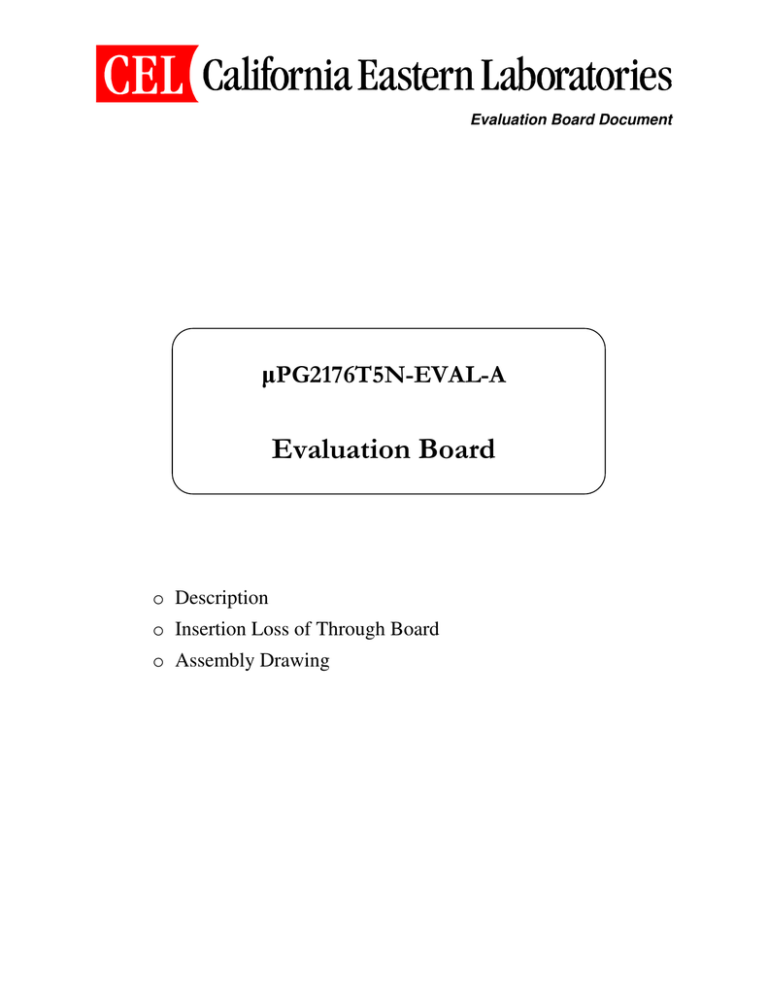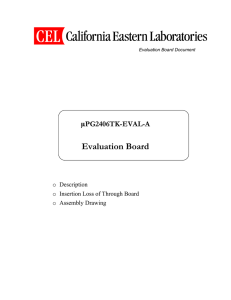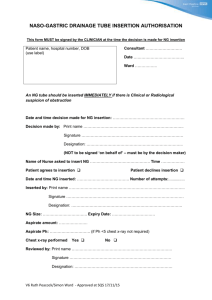Evaluation Board
advertisement

Evaluation Board Document µPG2176T5N-EVAL-A Evaluation Board o Description o Insertion Loss of Through Board o Assembly Drawing Evaluation Board File Description uPG2176T5N-EVAL-A SPDT Switch Evaluation Board for WiMAX Description: Selection of DC Blocking Capacitors: The switch requires a DC blocking capacitor at all its RF ports. On this evaluation board, two 18pF DC blocking capacitors are used in parallel for minimizing the parasitic effects over a wider frequency range. For frequencies higher than 5GHz, using a DC blocking capacitor with smaller value can improve the insertion loss by 0.05 to 0.1 dB. Switch Logic Table: The following table lists the different possible states of the switch depending on the voltages applied to the 3 control pins. The high state (H) corresponds to a voltage of 2.8V The low logic state (L) corresponds to a voltage of 0.0V The ON state means that the switch is passing between the two specified ports, while the path between all other ports is OFF (blocked). A signal through an ON (passing) path will suffer only the switch low insertion loss. Any signal going through an OFF (blocked) path will be strongly attenuated according to the switch’s isolation specification. Vcont1 Vcont2 L H H L INPUTINPUTOUTPUT1 OUTPUT2 measure ISO measure measure measure ISO IL IL 2 DC supply connectors: P1 is control voltage Vcont1, P3 is Vcont2, P2 and P4 are the ground pins. For normal operation, Vcont pins should be connected to a power supply capable of supplying 0V and 2.8V independently of each other. RF connectors: As indicated on the board, J1 is connected to RFout1, J2 to RFout2. Information on Board Material: The board material is 20 mil thick Duroid 6002. Its dielectric constant is 2.94. Insertion Loss of Through: Because the insertion loss through the switch (in pass mode) is low, it is necessary to consider the loss through the connectors, capacitors and board traces when evaluating this device. To that end, an identical board was characterized to determine the extraneous board loss. This board loss needs to be factored in when assessing the insertion loss through the switch alone. In the table below are typical loss values of the PCB+components for different frequency points: INPUT FREQUENCY (GHz) BOARD LOSS (dB) 2.0 0.12 3.5 0.19 4.0 0.22 3 Evaluation Board Insertion Loss Evaluation Board Isolation Evaluation Board Return Losses 4 Through Board Insertion Loss 5 Through Board Return Loss 6



